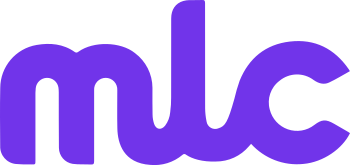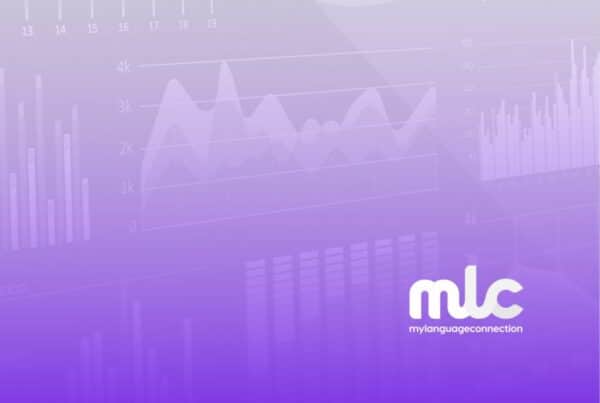The Importance of Language in a Global Economy
As the world becomes increasingly connected, the need for expert translation services is continually on the rise. With companies striving to compete across borders and thrive internationally, consumer demands constantly evolving, and health issues making an impact on a global level, the translation industry shows no sign of slowing and the translation industry trends and statistics highlight just that.
The Role of Translation Services
In this globalised economy, consideration of language and cultural implications are integral to communicating on a global stage. Translation services are key to successfully exporting products and services, no matter the industry, though absolutely critical in some, as the pandemic has highlighted. Industry trends and stats are a great place to start in order to realise the impact and opportunity associated with language, translation, and localisation services.
Looking for some specific stats? Hop over to one of these sections for topical stats at-a-glance:
General Language Statistics
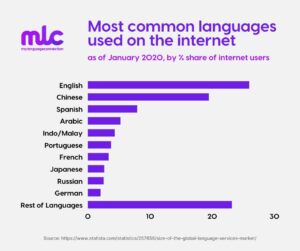 There are over 7000 languages spoken globally, though around 42% of those are at risk of extinction (Source)
There are over 7000 languages spoken globally, though around 42% of those are at risk of extinction (Source)- Hindi is the 3rd most-spoken language in the world, after English (1st) and Chinese (2nd) (Source)
- The most popular language used online is English (25.9%) followed by Chinese (19.4%) and then Spanish (7.9%) (Source)
- China is the largest online community in the world, with over 1 billion internet users (Source), which explains why it’s the second most-used language on the internet.
- The countries with the highest English Proficiency Index worldwide are the Netherlands, Denmark, Finland, Sweden, and Norway. In Asia, it’s Singapore, the Philippines, Malaysia, South Korea, and Hong Kong, while in Africa, the best English-speaking countries are Uganda, South Africa, Kenya, Nigeria, Ethiopia, and Ghana.
Trends & Statistics: Why are Translation Services in High Demand?
Despite the harsh impact of the pandemic hitting in 2020 and continuing to cause disruption throughout 2021, the translation industry is one of few global industries to experience continued growth.
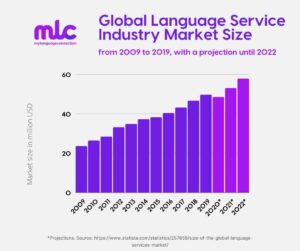 After doubling in size over the course of a decade (from 2009-2019), the global language services industry was worth between $47.5 billion and $48.4 billion. USD in 2020, compared to $49.6 billion in 2019. Moving into 2021, when the heat of the pandemic had started to subside, the overall market value rose considerably to $51.6 billion, according to Statista.
After doubling in size over the course of a decade (from 2009-2019), the global language services industry was worth between $47.5 billion and $48.4 billion. USD in 2020, compared to $49.6 billion in 2019. Moving into 2021, when the heat of the pandemic had started to subside, the overall market value rose considerably to $51.6 billion, according to Statista.
While some industries have relied on translation and localisation services since their inception, owing to rapid globalisation, it’s becoming increasingly important to more and more sectors.
Translation services companies have, over the years, helped to bridge diplomatic gaps between several countries, fostering international relationships and market developments. Such services have been integral to companies looking to expand into international markets, in need of solid translation and localisation of marketing materials.
The Impact of COVID-19 on the Translation Services Market
Those requirements are never going away, but what has arguably contributed to the continued growth of the translation industry even in a time of global crisis, is the critical part the industry plays in the medical and life sciences sector, and the increased demand for healthcare translations due to the impact of COVID-19.
As of 2020, the demand for healthcare translations, including telehealth services, increased by 49%.
Growing Demand for Translation Services Industry
Here are areas we believe will record increased demand for translation and language services this year and in the coming years:
- Website translations
- Medical/healthcare translations
- Ecommerce translations
- Finance translations
- Legal services translations
- Manufacturing industry translations
- Business translations
- E-learning programs/Online certifications
- Media translations
- Collaborations tools
- Software translation and localisation
- Machine translations
- Marketing, advertising, PR.
Translation Industry Statistics
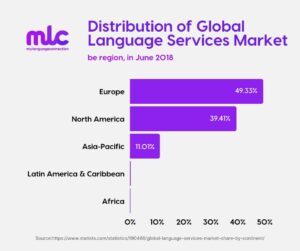 In 2021, the global translation industry rose to $56.18 billion USD (that’s a growth of more than $5 billion within 2 years).
In 2021, the global translation industry rose to $56.18 billion USD (that’s a growth of more than $5 billion within 2 years).- Europe is home to the largest language services market in the world, comprising almost half of the global market at 49%. North America follows this at 39.41%.
- In the U.S. alone, the market size of translation services is USD 6.6 billion, with TransPerfect, Lionbridge Technologies, and RWS Holdings taking the market lead. Growing Diversity in the United States has increased the need for professional interpreters and translators.
- As of 2020, the demand for healthcare translations, including telehealth services, increased by 49%.
- However, there was understandably a decline in the demand for translation services for tourism, events, travel, and leisure, which was also due to the impact of COVID.
Business Across Borders: Global Language Market Statistics
In a nutshell, companies that are currently serving or looking to break into foreign markets need the help of expert translators. As bilateral trade between major exporting countries like Germany, Japan, Russia, China, the US, the UK, Hong Kong, South Korea, etc., and the rest of the world continues, we can expect continued dependency on the language and translation industry.
If you’re looking to translate your marketing materials to other languages as you enter into foreign markets, here are some global market statistics about translating and localising content for global audiences.
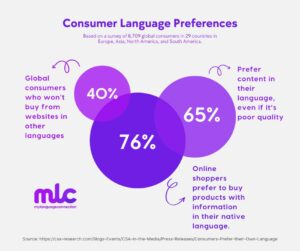 Over 50% of all queries on Google are made in languages other than English (Source)
Over 50% of all queries on Google are made in languages other than English (Source)- According to a large-scale behavioural survey of 8,709 global consumers in 29 countries across Europe, Asia, North America, and South America, conducted by CSA Research in 2020, it was found that 76% of online shoppers prefer to buy products with information in their native language.
- In other words, localising your website content or global marketing campaigns increases your chances for sales by more than 50%.
- 65% of these people prefer content in their language, even if it’s poor quality, while another 40% of global consumers won’t buy in other languages (Source) even though they understand the other language.
- Another important thing to note is that translating and localising your website for the United States, China, Japan, and Germany can give you access to 50% of worldwide sales potential, according to Translated.
- According to the survey carried out by CSA Research on Fortune 500 companies, businesses that invest in translation services are 1.5 times more likely to increase their revenue from international sales.
- The top 5 languages to translate international marketing content into are English, Spanish, Arabic, Chinese, and French (Source)
Why is Localisation important in Translation Services?
It’s not enough just to translate. To truly communicate those marketing messages or technical features, it’s important to also get the local and cultural context right and convey your information in an appropriate tone for your audience. This is why localisation is at the core of the translation industry.
When looking specifically at online business and marketing content, what you might need to pay extra attention to is that while the English Language is the most used language on the internet, the majority of internet users actually prefer to have content in their own languages or dialects. Therefore, it’s safe to say that English is a language of necessity. This means that you can expect better engagements and conversions from your ads, websites, and social media when the content you push out there is localised in the languages of your target audience.
Translation & Localisation Industry Statistics at a Glance
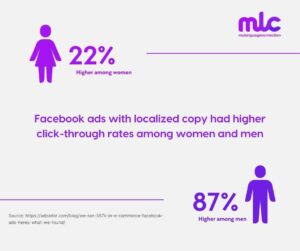 86% of localized campaigns will outperform English campaigns in both click-throughs and conversions (Source).
86% of localized campaigns will outperform English campaigns in both click-throughs and conversions (Source).- Brands using localization services are 1.5 times more likely to make more profit than those that don’t (Source)
- Facebook ads with localized copy had 22% higher click-through rates among women and 87% higher click-through rates among men (Source)
- 75% of consumers will consider buying from the same brand if the aftersales services are in their native language (Source)
- Close to 46% of all Google searches are seeking local information
Machine Translation (Statistics)
While machine translation provides cost-effective and faster translation, it has a bad reputation for poor accuracy and lack of localisation. This has reduced dependency on machine translation by both translation companies and consumers. When we talk about machine translation (MT), we’re simply referring to the use of artificial intelligence and translation memory to translate original texts from one language (source language) to another (target language).
Machine Translation Services
Machine translation can be Statistical Machine Translation (SMT) or the newer Neural Machine Translation (NMT) – which are the two most common machine translation systems currently in use. Some experts believe that machine translation is actually the future of the translation industry.
Previously, machine translation systems used software to first translate, and a human translator works on the result and manually fixes all the errors. However, the current conversation about Machine Translation is centred on adopting a hybrid solution, where both human translators and software work simultaneously on translation projects to produce excellent translations. This is essentially the future of Machine translation post-editing (MTPE) services.
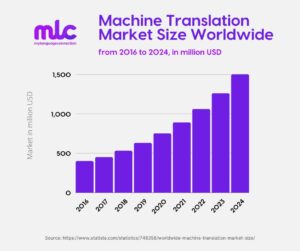 Key Statistics on Machine Translation
Key Statistics on Machine Translation
- Between 2016 and 2022, the US machine translation market grew from $400 million to $1.1 billion USD (Source)
- The global Machine Translation market is expected to rise considerably between 2022 and 2028. In 2020, it was valued at $153.8 million USD. The market is expected to hit $230.67 million USD by 2026 while recording a CAGR of 7.1% between 2021 and 2026.
- According to a Global Market Insights survey, as of 2020, the global machine translation market was valued at $650 million and is expected to reach $3 billion by 2027.
- SMT alone contributed to more than 65.0% of the overall global translation market revenue.
- In a 2020 report by Intento, Amazon is the top-performing machine translation provider globally. Since machine translations are faster, it helps to save the cost of getting quality translations.
- Concerning business usage of machine translation, CSA Research in 2020 found that the percentage of projects for end-clients using machine translations climbed from 13% in 2019 to 24% in 2020.
Are businesses able to get the same quality from machine translation output as they would with a professional, human linguist? Check out our blog post on Machine Translations here
Translation Memory Statistics
One crucial factor that makes machine translation an attractive solution is the fact that it uses translation memory (TM). TM is most useful in situations where a translator has a document that is large and contains repetitive and recyclable content. Translation memories record all your approved translations, allowing you to reuse them in new projects. So, as you work on new translation projects, the database suggests translations based on matching words or terminologies or segments between your old and new content.
A study reported that 82.5% of professional translators still use TM technology, with those who specialise in technical, financial, or marketing texts reported as being more likely to use TM tools. Generally, translators admitted that using translation memory saves them more time, guarantees consistency in terminology, and improves the quality of the translation output.
Statistics about Translators and Interpreters
Behind the scenes are expert translators, whose work altogether accounts for the bloom and explosion of the translation industry at large. Many of them work as freelancers, while a good number of them offer their services as certified and registered translation companies.
If you’re looking to join the translation industry as a translator or recruit more translators to join your team, here are some stats to brush through.
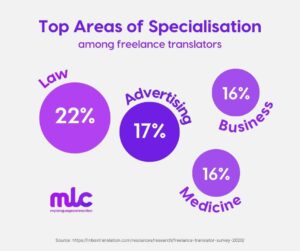 There are approximately 640,000 translators in the world.
There are approximately 640,000 translators in the world.- According to ProZ’s State of Industry Report in 2020, which surveyed 7,000 professional translators and interpreters, it was found that 75% of respondents were self-employed/freelancers.
- These translation and interpretation professionals altogether represented 178 countries and constituted 155 language pairs.
- Apart from dealing with language structure, missing terms, and complex dialects, the issues of price and clients’ expectations happen to be the biggest challenges translators face.
- Generally, translators who belong to one or more professional language associations charge about 30% more than their counterparts who do not.
- From Inbox Translation’s report in 2020, we learned that the top specialisation areas for freelance translators are law (22%), advertising (17%), business (16%), and medicine (16%).
In the last 10 years, global communities have even become more tightly-knit than ever, thanks to huge technological advances. Language, translation, and localisation services are undeniably central to globalisation and growth, and these translation industry trends and statistics highlight the impact and opportunities of the industry.
Here at My Language Connection, we specialise in Life Science, Medical, and BioTech translations to help companies within the healthcare industry internationalise and stay compliant. We share a passion for languages and utilise a global network of over 1000 translators. Get in touch today to learn how we can help your company thrive across borders.
